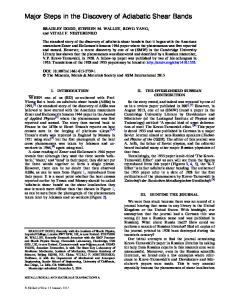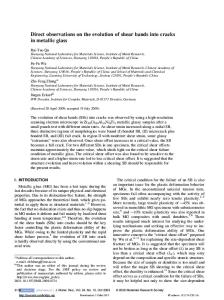Microscopic observations of adiabatic shear bands in three different steels
- PDF / 8,146,508 Bytes
- 15 Pages / 594 x 774 pts Page_size
- 2 Downloads / 352 Views
I.
INTRODUCTION
T H E formation of narrow zones of highly localized deformation known as adiabatic shear bands is an important phenomenon frequently occurring when materials are deformed at high strain rates. Whether or not it is accompanied by fracture, localization generally implies failure of the structural component through a loss in the load-carrying capacity of the highly deformed material within the shear band. tl'21 It has been reported that localization occurs more readily in materials with a low strain hardening rate, a low strain rate sensitivity, a low thermal conductivity, and a high thermal softening rate. Examples include alloys of titanium, aluminum, and copper as well as steels, ts-22j Shear bands have been observed in many practical applications involving dynamic deformation, including machining, ballistic impact, and high-velocity shaping and forming. Attesting to the significance of shear banding is the large number of recent studies, including experimental observations, analytical modeling, and metallurgical investigations. These are reviewed by Argon, 1231 Rogers, [24'251 Bedford e t a l . , I26| Clifton, [27] Olson et al., t281Hutchinson, tEqj and Timothy. t3~ Backman and Finnegan I311 have classified shear bands into either of two types, deformed and transformed, depending upon whether or not a phase transformation has occurred. According to this classification, transformed bands in steels may be as narrow as 5 or 10/xm and will appear white after etching with a Nital solution. Transformed bands were first observed by Zener and Hollomon t32~ and are presumed to involve a transformation from austenite to untempered martensite when the shear band material is quenched by the colder steel with which it is in contact. The available evidence for this transformation is mainly indirect, although microscopic studies have been made by Bedford et a l . [261 and K. CHO, formerly Research Associate, Brown University, is Research Scientist with the Research Institute of Science and Technology, Pohang, Korea. Y.C. CHI, formerly Research Assistant, Brown University, is Member of Technical Staff with Bell Telephone Laboratories, Holmdel, NJ. J. DUFFY, Professor of Engineering, is with the Division of Engineering, Brown University, Providence, RI 02912. Manuscript submitted October 26, 1988. METALLURGICAL TRANSACTIONS A
by Derep. t33] The subject has been reviewed by Rogers and Shastry tz~ who also showed, by means of microhardness measurements with a number of steels, that there is a considerable increase in hardness near the center of a transformed shear band. In contrast, deformed bands in steels generally remain fairly broad and do not etch white. Recent modeling of shear band initiation has concentrated on the role of defects, particularly geometric or dimensional variations, temperature differences, and the role of inclusions. Thus, Molinari and Clifton ]341 predicted critical conditions for shear band formation by considering the size of geometrical defects, while Wright and Walter t351 concentrated
Data Loading...











